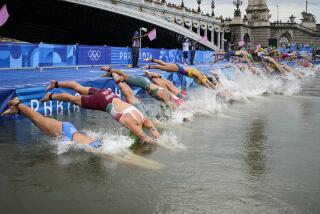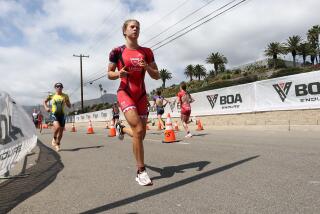He’s Caught by the Lure of Triathlon
- Share via
SAN DIEGO — I have never swum 2.4 miles, biked 112 miles or run 26.2 miles, but on Oct. 10 I intend to complete all three distances in a one-day torture test better known as the Ironman World Triathlon Championships.
Friends and relatives are not reluctant to suggest that I am slightly demented for even contemplating such an event. They say they could understand if I was an Olympic swimmer or a long-distance cyclist or a former track star or a beach bum who had nothing better to do than spend 40 hours a week preparing my body for such punishment. But to train for the Ironman while holding a full-time job and raising a young family, they say, is a recipe for disaster.
‘Are You Crazy?’
I’ve heard the same questions over and over since I began training for the Ironman in April: Why would anyone want to do this? Are you crazy? Is this some kind of macho thing?
I try to assure my friends that this is not a macho trip. I do admit, though, that I will purchase a lifetime supply of Ironman T-shirts should I finish the race in one piece. This is a once-in-a-lifetime event for me. I doubt that I have the discipline, the energy or the desire to do it again.
I prefer to think of the Ironman race as an exciting challenge, like climbing Mt. Everest or swimming the English Channel. When I first witnessed the race in 1984, I was fascinated by the athletes who tackled the course. They ranged in all ages, shapes and sizes. I told myself then that one day I’d like to join them.
Each year, more than 10,000 people pay the $150 entry fee for a chance to compete in the Ironman, the most prestigious triathlon in the world. Only 1,300 get the chance to broil in the humid Hawaiian heat for as long as 17 continuous hours. Most are professional triathletes and competitors who have raced in the Ironman before or qualified for the contest in other triathlons. There are 150 slots for part-time, amateur triathletes. This year I’m one of the lucky ones, I keep telling myself.
I began to think seriously about the Ironman two years ago when I moved to San Diego, the birthplace of the triathlon. I finished my first triathlon, the United States Triathlon Series in Solana Beach (1-mile swim, 25-mile bike, 6.2-mile run) last fall under three hours and competed in the San Diego International Triathlon in June.
Good Place to Train
“America’s Finest City” also is America’s best place to train for long-distance triathlons. We have perfect year-round weather conditions, an organized triathlon club, numerous cycling routes and the La Jolla Cove, a treasured spot where one can practice rough-water swimming without worrying about being ground into fish food. Thanks to legislation recently approved by the San Diego City Council, boats are prohibited from entering a mile-long swimming zone at the cove.
Last year, a friend had to talk me through my first rough-water swim in the cove. I felt like I had been tossed inside a washing machine as the waves pounded against my face and I gagged on salt water. I had a difficult time trying to concentrate on my swimming stroke at the same time I was thinking about sharks moving in for supper. When I finally emerged from the water, my weary legs buckled and I fell to the shore. My head felt like the washing machine was stuck on the spin cycle.
This summer my weekly swims in the cove are relatively uneventful. One afternoon last week, for instance, I felt invigorated after a one-mile rough-water swim after my first 100-mile bike ride. During the bike ride to San Onofre, I learned that the rear end was not meant to stay on a bike seat for seven hours.
Recently, I have put in about 20 hours per week swimming, riding and running. A part-time triathlete who wants to train for an endurance event such as the Ironman quickly learns how to juggle his work schedule, family life, social calender, finances and exercise routine. A high-carbohydrate diet and a minimum of eight hours’ sleep also become a mandatory part of training.
Conquering Fears
I did not anticipate, however, the importance of overcoming the many fears of a novice triathlete in serious training.
For me, running is the most painful and least enjoyable sport. I shudder at the thought of logging hundreds of miles on the road only to step in a pothole and twist an ankle that would put me out of the race.
I also worry on occasion about getting run over on my bike. Olympic cyclist and Ironman champion John Howard has been quoted as saying there are two kinds of cyclists: those who have been involved in a bad crash and those who will be. I’m in the latter category. But after cycling a couple of thousands miles on San Diego roads and several near-misses, I know that a serious mishap is only one open car door away.
Dave McJunkin, who operates a hostel in Hawaii for triathletes, told me recently that surviving 10 days of training on the Big Island before the race will provide a greater challenge than the Ironman itself. He said that, in the days leading up to the Ironman, two cyclists have been killed and several injured on Hawaii’s narrow highways by tourists who were busy looking out for volcanoes rather than cyclists on the road.
These fears were compounded when I received the Ironman contestant information packet in the mail. After reading the warnings, one wonders if Rambo is tough enough to finish the course:
- “The rocks and sides of the pier often have sea urchins on them. Always look before putting your feet down, as stepping on one could easily injure you seriously enough to keep you from competing in this race.”
- “While air temperatures may register in the high 80s to low 90s, temperatures along the bike portion of the course may effectively exceed 100 degrees Fahrenheit due to the reflected heat from the lava and asphalt. The legendary mumuku head winds of 5-35 m.p.h. are usual, and in extreme conditions, gusts may be encountered up to 55 m.p.h.”
- “No form of locomotion other than running, walking or crawling is allowed” in the marathon.
- “The majority of first-time contestants underestimate, by an amazing degree, the difficulty of the Ironman course and their preparation for the event. Most newcomers to the Ironman take 1 to 5 hours longer than they expect to complete the race.”
- “You will not be penalized for receiving medical evaluation. You will be withdrawn from the race only if you require transportation, IV fluids or if medical personnel feel your continued participation could result in permanent harm or death.”
In the last year, at least a half-dozen triathletes have died during competition when they drowned, suffered heart attacks or were hit by cars during the bike leg. At 31, I doubt that I will deteriorate to the point where my life is threatened, but I worry about dehydrating in the fierce Hawaiian heat. During the Los Angeles Marathon this year, I had to stop running after 17 miles before limping to the finish line because I ran out of gas in 70-degree heat. My body simply wasn’t prepared.
Just when I get so paranoid that I am scared to step foot on the Ironman course, I think about the diabetics, the athletes with artificial legs and the little old ladies who have finished the race.
If they can hold up, so can I.


